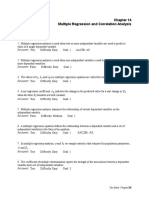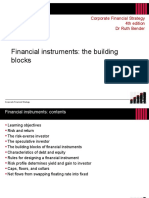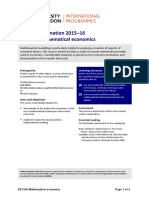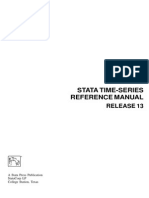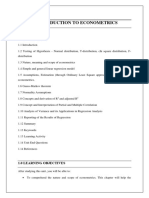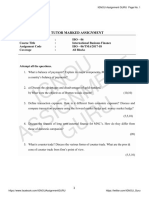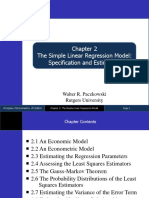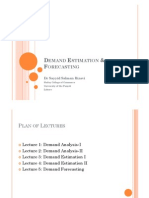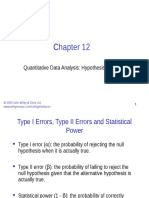Panel Data Problem Set 2
Uploaded by
Yadavalli ChandradeepPanel Data Problem Set 2
Uploaded by
Yadavalli ChandradeepDepartment of Economics
Econometric Analysis of Panel Data Assignment 2
Part I. Interpreting Regression Results
The results below show OLS, fixed effects and random effects estimates for a reduced version of the model analyzed in Assignment 1 (using the Cornwell and Rupert data). 1. Test the hypothesis of no effects vs. some effects using the results given below. 2. Explain in precise detail the difference between the fixed and random effects models. 3. Carry out the Hausman test for fixed effects against the null hypothesis of random effects and report your conclusion. Carefully explain what you are doing in this test. 4. In the context of the fixed effects model, test the hypothesis that there are no effects i.e., that all individuals have the same constant term. (The statistics you need to carry out the test are given in the results.) 5. Using the fixed effects estimator, test the hypothesis that all of the coefficients in the model save for the constant term are zero. Show all computations, and the appropriate degrees of freedom for F. 6. Discuss the impact of adding the individual dummy variables to the model in terms of the substantive change (or lack of) in the estimated results.
Part II. Fixed Effects Normalization
Some researchers (such as your professor) prefer to fit the conventional fixed effects model (estimator) by having exactly one dummy variable in the model for each individual. In some other cases, the researchers prefer to have a single overall constant and a set of N-1 individual dummy variables, i.e., dropping one of the individual constants to avoid the collinearity problem. A third way to proceed is to include an overall constant and the full set of dummy variables, but constrain the dummy variable coefficients to sum to zero. How does this manipulation of the dummy variable coefficients affect the least squares estimates of the other coefficients in the model and the fit of the equation, i.e., R2?
+----------------------------------------------------+ | OLS Without Group Dummy Variables | | LHS=LWAGE Mean = 6.676346 | | Standard deviation = .4615122 | | Model size Parameters = 5 | | Degrees of freedom = 4160 | | Residuals Sum of squares = 669.5138 | | Standard error of e = .4011743 | | Fit R-squared = .2451121 | | Adjusted R-squared = .2443862 | +----------------------------------------------------+ +----------------------------------------------------+ | Panel Data Analysis of LWAGE [ONE way] | | Unconditional ANOVA (No regressors) | | Source Variation Deg. Free. Mean Square | | Between 646.254 594. 1.08797 | | Residual 240.651 3570. .674093E-01 | | Total 886.905 4164. .212994 | +----------------------------------------------------+ +---------+--------------+----------------+--------+---------+----------+ |Variable | Coefficient | Standard Error |b/St.Er.|P[|Z|>z] | Mean of X| +---------+--------------+----------------+--------+---------+----------+ OCC -.36608081 .01346550 -27.187 .0000 .51116447 UNION .11154686 .01402315 7.954 .0000 .36398559 MS .32218316 .01629572 19.771 .0000 .81440576 EXP .00805812 .00057594 13.991 .0000 19.8537815 Constant 6.40050047 .01785232 358.525 .0000 +----------------------------------------------------+ | Least Squares with Group Dummy Variables | | Model size Parameters = 599 | | Degrees of freedom = 3566 | | Residuals Sum of squares = 83.86816 | | Standard error of e = .1533585 | | Fit R-squared = .9054373 | | Adjusted R-squared = .8895796 | +----------------------------------------------------+ +---------+--------------+----------------+--------+---------+----------+ |Variable | Coefficient | Standard Error |b/St.Er.|P[|Z|>z] | Mean of X| +---------+--------------+----------------+--------+---------+----------+ OCC -.02406298 .01384128 -1.738 .0821 .51116447 UNION .03515301 .01502985 2.339 .0193 .36398559 MS -.03226210 .01909579 -1.689 .0911 .81440576 EXP .09672164 .00119030 81.258 .0000 19.8537815 +--------------------------------------------------+ | Random Effects Model: v(i,t) = e(i,t) + u(i) | | Estimates: Var[e] = .235188D-01 | | Var[u] = .137422D+00 | | Corr[v(i,t),v(i,s)] = .853867 | | Lagrange Multiplier Test vs. Model (3) = 4352.48 | | ( 1 df, prob value = .000000) | | Fixed vs. Random Effects (Hausman) = 2554.11 | | ( 4 df, prob value = .000000) | +--------------------------------------------------+ +---------+--------------+----------------+--------+---------+----------+ |Variable | Coefficient | Standard Error |b/St.Er.|P[|Z|>z] | Mean of X| +---------+--------------+----------------+--------+---------+----------+ OCC -.10630712 .01284206 -8.278 .0000 .51116447 UNION .03971116 .01385277 2.867 .0041 .36398559 MS -.02642760 .01737054 -1.521 .1282 .81440576 EXP .05949249 .00091374 65.109 .0000 19.8537815 Constant 5.55660438 .02834081 196.064 .0000
Part III. Estimating Variance Components
Greene (2008), Wooldridge (2000, page 26), etc. suggest that in order to obtain the asymptotically efficient FGLS estimator of the coefficients in the random effects model, one only needs a consistent pair of estimators for 2 and u2 any consistent estimators will do. That is good, because there are quite a few available. One is suggested in Greene (on pages 203-205) based on the degrees of freedom corrected OLS and FE estimators. A different one is used by the TSP computer program (and NLOGIT after Bruno and DeBonis), namely using the pooled OLS estimate, ee/NT (note no degrees of freedom correction) and eLSDVeLSDV//NT (again, no correction). A third that is completely different is proposed on page 261 of Wooldridge. Only one of these (the TSP/LIMDEP estimator) is guaranteed to produce a positive estimate of u2. Show this. (In fact, I have never seen the Wooldridge estimator implemented either in software or in any application.) For each estimator, show how the residuals are used to compute the two variance component estimators. The Wooldridge estimator appears to use cross observation products (covariances) to estimate a variance. Can you justify this computation? If you are not using NLOGIT (since the answer for that appears above), determine exactly how your software computes the variance components. Note that the TSP/NLOGIT estimator is not, in fact, consistent. The estimator of 2 converges to 2 (T-1)/T. What does this imply? The estimator of based on this estimator is still consistent, since this is just weighted least squares with suboptimal weights as is, for example, OLS. But, it does raise an interesting question about the estimated standard errors. One hopes that T is large enough that the standard errors are nearly correct.
Part IV. The Hausman Test
We have considered two approaches to Hausmans test for random vs. fixed effects. A direct approach compares the random and fixed effects estimators using a Wald test and using Hausmans theoretical result on how to obtain the asymptotic covariance matrix for the difference. A second approach is a variable addition test, in which the group means of the time varying variables are added to the regression (each group mean is repeated for each observation in the group), then an F (or Wald) test is used to test the significance of the coefficients on the means. A large F weighs against the random effects specification. 1. Using the bank cost data on the course website, carry out this test both ways with respect to the following model logCi,t = 1logY1i,t + 2logY2i,t + 3logY3i,t + 4logY4i,t + 5logY5i,t + i + i,t (Note for the direct test, you use only the first 5 coefficients). 2. Using the preferred model based on the outcome of part (1), now test the hypothesis that 1+2+34+5 = 1. NOTE: In the data set, variable variable C is the log of the costs, and variables Q1,,Q5 are the logs of the outputs. So, you need not transform the data after reading them into your program.
Part V. Heteroscedasticity in the Fixed Effects Model
As we saw in class, there is ample evidence of heteroscedasticity in the Baltagi/Griffin gasoline demand data. Consider the model logGi,t = 1 + 2logYi,t + 3logPi,t + 4logCi,t + i + i,t E[i|xi] = g(xi) (i.e., a fixed effects model) E[i,t|xi] = 0 Var[i,t|xi] = i2 Note that i above refers to the country, not the period. There are 18 countries in the data set. 1. How would you estimate the parameters of this model? Suggest a two step, efficient estimator. 2. Using the Baltagi/Griffin data, compute the estimates of the model and report your results. Does the assumption of heteroscedasticity substantially change the model results compared to the simpler fixed effects model?
Part VI. Algebra for the Two Period Model
1. [This is Wooldridges problem 10.2, page 292.] Suppose you have T=2 years of data on the same group of N working individuals. Consider the following model of wage determination: Log(wageit) = 1 + 2 d2t + zit + 1 femalei + 2 d2tfemalei + ci + it. The unobserved effect, ci is allowed to be correlated with zit and with femalei. The variable d2 is a time period indicator; d2t = 1 if t=2 and 0 if t=1. In what follows: assume that E[it|femalei,zi1,zi2,ci] = 0, t = 1,2. a. Without further assumptions, what parameters in the log wage equation can be consistently estimated? b. Interpret the coefficients 1 and 2. c. Write the log wage explicitly for the two time periods. Show that the differenced equation can we written as where log(wageit) = 2 + zit + 2 femalei + it log(wageit) = log(wagei2) - log(wagei1).
2. Continuing part (1), discuss estimation of the model under the random effects assumption. How would you proceed? Can it be done?
Part VII. The Random Effects Model
1. [Based on Wooldridge, problem 10.5, page 293. ] a. Consider an extension of the random effects model in which the variance of ui differs across individuals. How does the covariance matrix of the disturbance vector in the RE model change if the individual component is heteroscedastic? b. How would this change the behavior (asymptotic properties) of the OLS estimator and the GLS estimator c. Given this modification of the model, how would you modify your estimation and inference procedures? 2. [Based on Wooldridge, problem 10.14, page 297] Suppose we specify the unobserved effects model yit = + xit + zi + hi + it, i = 1,,N; t = 1,,T. xit is a set of time varying variables while zi is a set of time invariant variables. We assume that E[it|xi, zi,hi] = 0, I.e., it is uncorrelated with xis for all periods, as well as with zi and hi. E[hi | xi,zi] = 0. (The random effects specification). If we use the fixed effects estimator to estimate this random effects model, we are implicitly estimating the parameters of the equation yit = xit + ci + it where ci = + zi + ui. a. Obtain c2 = Var[ci|zi]. Show that this is at least as large as h2. b. Explain why estimation of the model by fixed effects will lead to a larger estimated variance of the unobserved effect (the disturbance) than if the model is estimated by the random effects procedure. 3. The Lagrange multiplier statistic for testing the hypothesis that u2 = 0 in the model yit = xit + ui + it appears on slide 27 of PanelDataNotes-5 (Random Effects). Derive the probability limit of (1/N)LM under the null hypothesis that u2 is actually zero. Hint: a simpler form to work with is
1 T N 1 ( tT=1eit )2 i= LM= N T 2 1 . N 2(T-1) i=1 t =1eit
You can obtain the probability limits of the two sums and use the Slutsky theorem to obtain the end result.
Part VIII. The Fixed Effects Model
[Based on Wooldridge, problem 10.3, page 292.] For T = 2, consider the standard unobserved effects model, yit = xit + ci + it, i = 1,,N; t = 1,2. Let bFE and bD denote the fixed effects (within) and first difference estimators, respectively. 1. Show that the two estimators are numerically identical. 2. Show that the estimates of the disturbance variance from the two estimators are also identical.
Part IX. Homogeneity
Alicia Munnells statewide productivity data appear on the course website. These data are for the 48 states (excluding Alaska and Hawaii) and the 17 years 1970-1986. Consider the model, lnGSPit = 1 + 2 lnEMPit + 3 lnP_Capit + it. 1. Compute the estimates of the parameters, using least squares. 2. We are interested in determining if the coefficients of the model changed over time we wish to test this statistically. To do this, compute the regression separately for the 17 years, then test the hypothesis of homogeneity. (Note, there are three ways to do this. The most straightforward will be to use the Chow test, based on the sums of sqaured residuals.) 3. Compute fixed and random (state) effects models and determine which of the two would be the preferred specification. Note: For NLOGITs purposes, you have to rearrange the data. They are arranged by state in blocks of 17 observations, but for this exercise, you need them arranged by year in blocks of 48 states. To obtain this form, just use the commands SAMPLE ; All $ CREATE ; Obs = Trn(1,1) $ SORT ; LHS= YR ; RHS = * $ (Note, the states may end up out of order, but that does not matter.) Then, you can analyze the data as a panel with ;PDS=48. If you need to restore the original form of the data, the instruction SORT ; Lhs = Obs ; Rhs = * $ will put the data back the way they were when you started.
You might also like
- Assessment On Correlation and Regression - S-MATH201LA - STATISTICAL ANALYSIS WITH COMPUTER APPLICATION - BSA21 - 1S - AY20-21 - DLSU-D College - GS0% (1)Assessment On Correlation and Regression - S-MATH201LA - STATISTICAL ANALYSIS WITH COMPUTER APPLICATION - BSA21 - 1S - AY20-21 - DLSU-D College - GS2 pages
- University of Michigan Rackham Graduate School Statement of PurposeNo ratings yetUniversity of Michigan Rackham Graduate School Statement of Purpose2 pages
- Chapter14 Multiple Regression and Correlation Analysis100% (6)Chapter14 Multiple Regression and Correlation Analysis18 pages
- Bekaert International Financial Management 2e100% (1)Bekaert International Financial Management 2e6 pages
- Financial Instruments: The Building Blocks: Corporate Financial Strategy 4th Edition DR Ruth Bender100% (1)Financial Instruments: The Building Blocks: Corporate Financial Strategy 4th Edition DR Ruth Bender12 pages
- Solutions Manual to Accompany Introduction to Quantitative Methods in Business: with Applications Using Microsoft Office ExcelFrom EverandSolutions Manual to Accompany Introduction to Quantitative Methods in Business: with Applications Using Microsoft Office ExcelNo ratings yet
- (F23) ECON - 536 Topics in Mathematical Methods For EconomistNo ratings yet(F23) ECON - 536 Topics in Mathematical Methods For Economist3 pages
- Development Economics: by Debraj Ray, New York University0% (2)Development Economics: by Debraj Ray, New York University31 pages
- Econometrics Example Questions and SolutionsNo ratings yetEconometrics Example Questions and Solutions5 pages
- Econometrics - Chapter 1 - Introduction To Econometrics - Shalabh, IIT KanpurNo ratings yetEconometrics - Chapter 1 - Introduction To Econometrics - Shalabh, IIT Kanpur11 pages
- APRIL 2019 International Finance Question PaperNo ratings yetAPRIL 2019 International Finance Question Paper9 pages
- Responsiveness and Productivity of Tax YieldsNo ratings yetResponsiveness and Productivity of Tax Yields30 pages
- Chapter 3 Economic and Econometric ModelsNo ratings yetChapter 3 Economic and Econometric Models41 pages
- A Koutsoyiannis - Theory of Econometrics - An Introductory Exposition of Econometric Methods (1977, Macmillan) - Libgen - Li (1) - 1-35 - CompressedNo ratings yetA Koutsoyiannis - Theory of Econometrics - An Introductory Exposition of Econometric Methods (1977, Macmillan) - Libgen - Li (1) - 1-35 - Compressed35 pages
- Ize y Yeyati (2003) - Financial DollarizationNo ratings yetIze y Yeyati (2003) - Financial Dollarization25 pages
- Teaching Note 00-04: Girsanov'S Theorem in Derivative PricingNo ratings yetTeaching Note 00-04: Girsanov'S Theorem in Derivative Pricing16 pages
- TP2003 - 4 Poverty and Inequality MeasuresNo ratings yetTP2003 - 4 Poverty and Inequality Measures30 pages
- Principles of Macroeconomics Practice AssignmentNo ratings yetPrinciples of Macroeconomics Practice Assignment4 pages
- The Solution of Nonlinear Hyperbolic Differential Equations Finite DifferencesNo ratings yetThe Solution of Nonlinear Hyperbolic Differential Equations Finite Differences13 pages
- Multicollinearity Among The Regressors Included in The Regression ModelNo ratings yetMulticollinearity Among The Regressors Included in The Regression Model13 pages
- Homoscedastic That Is, They All Have The Same Variance: Heteroscedasticity100% (1)Homoscedastic That Is, They All Have The Same Variance: Heteroscedasticity11 pages
- The Simple Linear Regression Model: Specification and EstimationNo ratings yetThe Simple Linear Regression Model: Specification and Estimation66 pages
- The Basic New Keynesian Model: Josef StráskýNo ratings yetThe Basic New Keynesian Model: Josef Stráský29 pages
- CHARLES GOODHART - Monetary Economics - An Integrated Approach To Credit, Money, Income, Production and Wealth. by WYNNE GODLEY and MARC LAVOIE100% (1)CHARLES GOODHART - Monetary Economics - An Integrated Approach To Credit, Money, Income, Production and Wealth. by WYNNE GODLEY and MARC LAVOIE2 pages
- Beyond Crisis: The Financial Performance of India's Power SectorFrom EverandBeyond Crisis: The Financial Performance of India's Power SectorNo ratings yet
- Applications of Derivatives Errors and Approximation (Calculus) Mathematics Question BankFrom EverandApplications of Derivatives Errors and Approximation (Calculus) Mathematics Question BankNo ratings yet
- Risk and Financial Management: Mathematical and Computational MethodsFrom EverandRisk and Financial Management: Mathematical and Computational MethodsNo ratings yet
- Econometrics: Econometrics Unleashed, Mastering Data-Driven EconomicsFrom EverandEconometrics: Econometrics Unleashed, Mastering Data-Driven EconomicsNo ratings yet
- On The Principles of Political Economy, and Taxation. IllustratedFrom EverandOn The Principles of Political Economy, and Taxation. IllustratedNo ratings yet
- Evaluating Military Advertising and Recruiting Theory and Methodology 1st Edition Committee On The Youth Population And Military Recruitment -- Phase Ii all chapter instant download100% (3)Evaluating Military Advertising and Recruiting Theory and Methodology 1st Edition Committee On The Youth Population And Military Recruitment -- Phase Ii all chapter instant download77 pages
- Introduction To Stata - Lecture 4: Instrumental Variables: Hayley Fisher 3 March 2010No ratings yetIntroduction To Stata - Lecture 4: Instrumental Variables: Hayley Fisher 3 March 201011 pages
- Model Sum of Squares DF Mean Square F Sig. 1 Regression .456 4 .114 1.388 .252 Residual 3.942 48 .082 Total 4.398 52 A. Predictors: (Constant), LC, DEBT, TANG, EXT B. Dependent Variable: DPRNo ratings yetModel Sum of Squares DF Mean Square F Sig. 1 Regression .456 4 .114 1.388 .252 Residual 3.942 48 .082 Total 4.398 52 A. Predictors: (Constant), LC, DEBT, TANG, EXT B. Dependent Variable: DPR3 pages
- Normality in The Residual - Hossain Academy NoteNo ratings yetNormality in The Residual - Hossain Academy Note2 pages
- Minitab Multiple Regression Analysis PDFNo ratings yetMinitab Multiple Regression Analysis PDF6 pages
- Quantitative Data Analysis: Hypothesis Testing: © 2009 John Wiley & Sons LTDNo ratings yetQuantitative Data Analysis: Hypothesis Testing: © 2009 John Wiley & Sons LTD39 pages
- Simple and Bias-Corrected Matching Estimators For Average Treatment EffectsNo ratings yetSimple and Bias-Corrected Matching Estimators For Average Treatment Effects57 pages
- Industrial Pollution in Economic Development: Kuznets RevisitedNo ratings yetIndustrial Pollution in Economic Development: Kuznets Revisited40 pages
- Forecasting: Francis X. Diebold University of PennsylvaniaNo ratings yetForecasting: Francis X. Diebold University of Pennsylvania323 pages
- Probit and Logit Models Stata Program and Output PDFNo ratings yetProbit and Logit Models Stata Program and Output PDF10 pages
- Panel Data Analysis Using EViews Chapter - 2 PDFNo ratings yetPanel Data Analysis Using EViews Chapter - 2 PDF51 pages
- Rekapitulasi Data Uji Hedonik Mutu Es Krim BP2No ratings yetRekapitulasi Data Uji Hedonik Mutu Es Krim BP24 pages
- Assessment On Correlation and Regression - S-MATH201LA - STATISTICAL ANALYSIS WITH COMPUTER APPLICATION - BSA21 - 1S - AY20-21 - DLSU-D College - GSAssessment On Correlation and Regression - S-MATH201LA - STATISTICAL ANALYSIS WITH COMPUTER APPLICATION - BSA21 - 1S - AY20-21 - DLSU-D College - GS
- University of Michigan Rackham Graduate School Statement of PurposeUniversity of Michigan Rackham Graduate School Statement of Purpose
- Chapter14 Multiple Regression and Correlation AnalysisChapter14 Multiple Regression and Correlation Analysis
- Financial Instruments: The Building Blocks: Corporate Financial Strategy 4th Edition DR Ruth BenderFinancial Instruments: The Building Blocks: Corporate Financial Strategy 4th Edition DR Ruth Bender
- Solutions Manual to Accompany Introduction to Quantitative Methods in Business: with Applications Using Microsoft Office ExcelFrom EverandSolutions Manual to Accompany Introduction to Quantitative Methods in Business: with Applications Using Microsoft Office Excel
- (F23) ECON - 536 Topics in Mathematical Methods For Economist(F23) ECON - 536 Topics in Mathematical Methods For Economist
- Development Economics: by Debraj Ray, New York UniversityDevelopment Economics: by Debraj Ray, New York University
- Econometrics - Chapter 1 - Introduction To Econometrics - Shalabh, IIT KanpurEconometrics - Chapter 1 - Introduction To Econometrics - Shalabh, IIT Kanpur
- A Koutsoyiannis - Theory of Econometrics - An Introductory Exposition of Econometric Methods (1977, Macmillan) - Libgen - Li (1) - 1-35 - CompressedA Koutsoyiannis - Theory of Econometrics - An Introductory Exposition of Econometric Methods (1977, Macmillan) - Libgen - Li (1) - 1-35 - Compressed
- Teaching Note 00-04: Girsanov'S Theorem in Derivative PricingTeaching Note 00-04: Girsanov'S Theorem in Derivative Pricing
- The Solution of Nonlinear Hyperbolic Differential Equations Finite DifferencesThe Solution of Nonlinear Hyperbolic Differential Equations Finite Differences
- Multicollinearity Among The Regressors Included in The Regression ModelMulticollinearity Among The Regressors Included in The Regression Model
- Homoscedastic That Is, They All Have The Same Variance: HeteroscedasticityHomoscedastic That Is, They All Have The Same Variance: Heteroscedasticity
- The Simple Linear Regression Model: Specification and EstimationThe Simple Linear Regression Model: Specification and Estimation
- CHARLES GOODHART - Monetary Economics - An Integrated Approach To Credit, Money, Income, Production and Wealth. by WYNNE GODLEY and MARC LAVOIECHARLES GOODHART - Monetary Economics - An Integrated Approach To Credit, Money, Income, Production and Wealth. by WYNNE GODLEY and MARC LAVOIE
- Portfolio Performance Measurement and BenchmarkingFrom EverandPortfolio Performance Measurement and Benchmarking
- Beyond Crisis: The Financial Performance of India's Power SectorFrom EverandBeyond Crisis: The Financial Performance of India's Power Sector
- Applications of Derivatives Errors and Approximation (Calculus) Mathematics Question BankFrom EverandApplications of Derivatives Errors and Approximation (Calculus) Mathematics Question Bank
- Structural Equation Modeling: Applications Using MplusFrom EverandStructural Equation Modeling: Applications Using Mplus
- Risk and Financial Management: Mathematical and Computational MethodsFrom EverandRisk and Financial Management: Mathematical and Computational Methods
- Econometrics: Econometrics Unleashed, Mastering Data-Driven EconomicsFrom EverandEconometrics: Econometrics Unleashed, Mastering Data-Driven Economics
- On The Principles of Political Economy, and Taxation. IllustratedFrom EverandOn The Principles of Political Economy, and Taxation. Illustrated
- Evaluating Military Advertising and Recruiting Theory and Methodology 1st Edition Committee On The Youth Population And Military Recruitment -- Phase Ii all chapter instant downloadEvaluating Military Advertising and Recruiting Theory and Methodology 1st Edition Committee On The Youth Population And Military Recruitment -- Phase Ii all chapter instant download
- Introduction To Stata - Lecture 4: Instrumental Variables: Hayley Fisher 3 March 2010Introduction To Stata - Lecture 4: Instrumental Variables: Hayley Fisher 3 March 2010
- Model Sum of Squares DF Mean Square F Sig. 1 Regression .456 4 .114 1.388 .252 Residual 3.942 48 .082 Total 4.398 52 A. Predictors: (Constant), LC, DEBT, TANG, EXT B. Dependent Variable: DPRModel Sum of Squares DF Mean Square F Sig. 1 Regression .456 4 .114 1.388 .252 Residual 3.942 48 .082 Total 4.398 52 A. Predictors: (Constant), LC, DEBT, TANG, EXT B. Dependent Variable: DPR
- Quantitative Data Analysis: Hypothesis Testing: © 2009 John Wiley & Sons LTDQuantitative Data Analysis: Hypothesis Testing: © 2009 John Wiley & Sons LTD
- Simple and Bias-Corrected Matching Estimators For Average Treatment EffectsSimple and Bias-Corrected Matching Estimators For Average Treatment Effects
- Industrial Pollution in Economic Development: Kuznets RevisitedIndustrial Pollution in Economic Development: Kuznets Revisited
- Forecasting: Francis X. Diebold University of PennsylvaniaForecasting: Francis X. Diebold University of Pennsylvania
- Probit and Logit Models Stata Program and Output PDFProbit and Logit Models Stata Program and Output PDF


